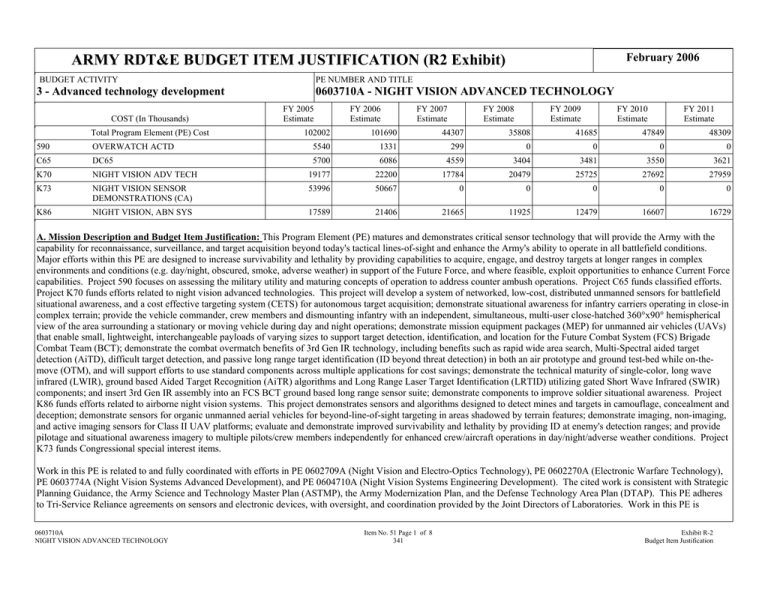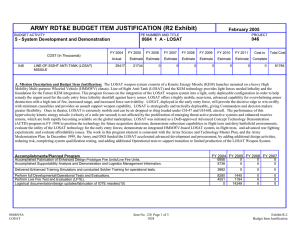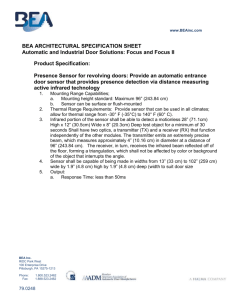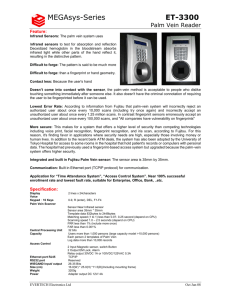ARMY RDT&E BUDGET ITEM JUSTIFICATION (R2 Exhibit) February 2006
advertisement

February 2006 ARMY RDT&E BUDGET ITEM JUSTIFICATION (R2 Exhibit) Budget Item Justification Exhibit R-2 BUDGET ACTIVITY PE NUMBER AND TITLE 3 - Advanced technology development 0603710A - NIGHT VISION ADVANCED TECHNOLOGY 0603710A NIGHT VISION ADVANCED TECHNOLOGY COST (In Thousands) Total Program Element (PE) Cost FY 2005 Estimate FY 2006 Estimate FY 2007 Estimate FY 2008 Estimate FY 2009 Estimate FY 2010 Estimate FY 2011 Estimate 102002 101690 44307 35808 41685 47849 48309 5540 1331 299 0 0 0 0 590 OVERWATCH ACTD C65 DC65 5700 6086 4559 3404 3481 3550 3621 K70 NIGHT VISION ADV TECH 19177 22200 17784 20479 25725 27692 27959 K73 NIGHT VISION SENSOR DEMONSTRATIONS (CA) 53996 50667 0 0 0 0 0 K86 NIGHT VISION, ABN SYS 17589 21406 21665 11925 12479 16607 16729 A. Mission Description and Budget Item Justification: This Program Element (PE) matures and demonstrates critical sensor technology that will provide the Army with the capability for reconnaissance, surveillance, and target acquisition beyond today's tactical lines-of-sight and enhance the Army's ability to operate in all battlefield conditions. Major efforts within this PE are designed to increase survivability and lethality by providing capabilities to acquire, engage, and destroy targets at longer ranges in complex environments and conditions (e.g. day/night, obscured, smoke, adverse weather) in support of the Future Force, and where feasible, exploit opportunities to enhance Current Force capabilities. Project 590 focuses on assessing the military utility and maturing concepts of operation to address counter ambush operations. Project C65 funds classified efforts. Project K70 funds efforts related to night vision advanced technologies. This project will develop a system of networked, low-cost, distributed unmanned sensors for battlefield situational awareness, and a cost effective targeting system (CETS) for autonomous target acquisition; demonstrate situational awareness for infantry carriers operating in close-in complex terrain; provide the vehicle commander, crew members and dismounting infantry with an independent, simultaneous, multi-user close-hatched 360°x90° hemispherical view of the area surrounding a stationary or moving vehicle during day and night operations; demonstrate mission equipment packages (MEP) for unmanned air vehicles (UAVs) that enable small, lightweight, interchangeable payloads of varying sizes to support target detection, identification, and location for the Future Combat System (FCS) Brigade Combat Team (BCT); demonstrate the combat overmatch benefits of 3rd Gen IR technology, including benefits such as rapid wide area search, Multi-Spectral aided target detection (AiTD), difficult target detection, and passive long range target identification (ID beyond threat detection) in both an air prototype and ground test-bed while on-themove (OTM), and will support efforts to use standard components across multiple applications for cost savings; demonstrate the technical maturity of single-color, long wave infrared (LWIR), ground based Aided Target Recognition (AiTR) algorithms and Long Range Laser Target Identification (LRTID) utilizing gated Short Wave Infrared (SWIR) components; and insert 3rd Gen IR assembly into an FCS BCT ground based long range sensor suite; demonstrate components to improve soldier situational awareness. Project K86 funds efforts related to airborne night vision systems. This project demonstrates sensors and algorithms designed to detect mines and targets in camouflage, concealment and deception; demonstrate sensors for organic unmanned aerial vehicles for beyond-line-of-sight targeting in areas shadowed by terrain features; demonstrate imaging, non-imaging, and active imaging sensors for Class II UAV platforms; evaluate and demonstrate improved survivability and lethality by providing ID at enemy's detection ranges; and provide pilotage and situational awareness imagery to multiple pilots/crew members independently for enhanced crew/aircraft operations in day/night/adverse weather conditions. Project K73 funds Congressional special interest items. Work in this PE is related to and fully coordinated with efforts in PE 0602709A (Night Vision and Electro-Optics Technology), PE 0602270A (Electronic Warfare Technology), PE 0603774A (Night Vision Systems Advanced Development), and PE 0604710A (Night Vision Systems Engineering Development). The cited work is consistent with Strategic Planning Guidance, the Army Science and Technology Master Plan (ASTMP), the Army Modernization Plan, and the Defense Technology Area Plan (DTAP). This PE adheres to Tri-Service Reliance agreements on sensors and electronic devices, with oversight, and coordination provided by the Joint Directors of Laboratories. Work in this PE is 0603710A NIGHT VISION ADVANCED TECHNOLOGY Item No. 51 Page 1 of 8 341 Exhibit R-2 Budget Item Justification ARMY RDT&E BUDGET ITEM JUSTIFICATION (R2 Exhibit) February 2006 Budget Item Justification Exhibit R-2 BUDGET ACTIVITY 3 - Advanced technology development PE NUMBER AND TITLE 0603710A - NIGHT VISION ADVANCED TECHNOLOGY 0603710A NIGHT VISION ADVANCED TECHNOLOGY performed by the Army Research, Development and Engineering Command/Communications-Electronics Research, Development and Engineering Center/Night Vision & Electronic Sensors Directorate (NVESD), Fort Belvoir, Virginia and the Army Space and Missile Defense Command, Huntsville, Alabama (the Overwatch ACTD). 0603710A NIGHT VISION ADVANCED TECHNOLOGY Item No. 51 Page 2 of 8 342 Exhibit R-2 Budget Item Justification ARMY RDT&E BUDGET ITEM JUSTIFICATION (R2 Exhibit) February 2006 Budget Item Justification Exhibit R-2 BUDGET ACTIVITY 3 - Advanced technology development PE NUMBER AND TITLE 0603710A - NIGHT VISION ADVANCED TECHNOLOGY 0603710A NIGHT VISION ADVANCED TECHNOLOGY FY 2005 FY 2006 FY 2007 Previous President's Budget (FY 2006) 102047 51761 49341 Current BES/President's Budget (FY 2007) 102002 101690 44307 -45 49929 -5034 B. Program Change Summary Total Adjustments Congressional Program Reductions -446 Congressional Rescissions -1025 Congressional Increases 51400 Reprogrammings -45 SBIR/STTR Transfer Adjustments to Budget Years -5034 FY 07 decrease of -$5.0 million attributed to realignment of funding to higher priority requirements. Seventeen FY06 Congressional adds totaling $51400 were added to this PE. FY06 Congressional adds with no R-2A (appropriated amount is shown): ($5600) Buster Backpack UAV ($3000) Cerberus Sensor Suite ($2000) Cost Effective Targeting System ($5000) Digital Night Vision (DNV) Systems ($2800) Electron Bombarded Active Pixel Sensor Camera ($2800) Enhanced Digital Electronic Night-Vision for Unmanned Ground Vehicles ($1000) ISC Personal Miniature Thermal Vision System (PMTV) ($1000) Low Altitude Improvised Explosive Device Detection System (LAIDS) ($4200) Night Vision Advanced Technology (UPS Project) ($1000) Night Vision Fusion ($1100) Perimeter Security Technology Program ($4300) Pilot Port Security Sensor Technology Initiative in Tampa Bay ($1000) Portable Infrared Target Detection and Location Reporting System (COBRA-I PLUS) ($1000) Real-Time Geospatial Video Sensor Intelligence for NVESD ($11800)Sensor Technology fro Force Protection/Camera Assisted Monitoring System ($1000) Soldier Mobility and Rifle Targeting System (SMARTS) ($2800) Warfighter Position, Location and Tracking Sensor 0603710A NIGHT VISION ADVANCED TECHNOLOGY Item No. 51 Page 3 of 8 343 Exhibit R-2 Budget Item Justification February 2006 ARMY RDT&E BUDGET ITEM JUSTIFICATION (R2a Exhibit) Budget Item Justification Exhibit R-2A BUDGET ACTIVITY 3 - Advanced technology development PE NUMBER AND TITLE PROJECT 0603710A - NIGHT VISION ADVANCED TECHNOLOGY 590 0603710A (590) OVERWATCH ACTD COST (In Thousands) 590 OVERWATCH ACTD FY 2005 Estimate 5540 FY 2006 Estimate FY 2007 Estimate 1331 FY 2008 Estimate 299 FY 2009 Estimate 0 FY 2010 Estimate 0 FY 2011 Estimate 0 0 A. Mission Description and Budget Item Justification: This project matures and demonstrates technology that will enable real-time detection, location, and typing of small arms, mortars, and rocket propelled grenades (RPGs) in complex terrain. This Advanced Concept Technology Demonstration (ACTD) focuses on assessing the military utility of the technologies for locating enemy activity and real-time reporting of counter targeting information, and developing concepts of operation that address mobile force protection for forces involved in operations across the spectrum of conflict, from close combat to peacekeeping operations. The ACTD will mature and integrate a sensor/processor suite containing mid-wave infrared sensor, Electro-optical infrared imaging sensor, laser rangefinder/designator on a HMMWV with the appropriate C4I interfaces to disseminate information. Final product for the ACTD is a technology demonstrator that can be used to determine operational utility and deliver system performance specifications in support of the Current Force and Future Force requirements. Work in this ACTD is performed by the Space and Missile Defense Command, and the Army Communications-Electronics Research, Development and Engineering Center/Night Vision and Electronic Sensors Directorate. Other agencies participating include the Office of the Secretary of Defense, U.S. Pacific Command, and Program Executive Office Intelligence, Electronic Warfare and Sensors. The cited work is consistent with Strategic Planning Guidance, the Army Science and Technology Master Plan (ASTMP), the Army Modernization Plan, and the Defense Technology Area Plan. FY 2005 Accomplishments/Planned Program FY 2006 FY 2007 Overwatch ACTD. In FY05, completed real time operational software, sensor shooter interfaces and communications hardware integration; demonstrated and evaluated the sensor/processor on a HMMWV; continued hardware/software maturation and conducted initial full-scale functionality tests, including capability to steer the sensor to respond to threats from a full 360 degree region of concern; performed major system demonstration 1 using a HMMWV platform. In FY06, build and integrate a second, more advanced, sensor system on an unmanned ground vehicle and conduct major system demonstration 2. In FY07, will provide system sustainment and technical support to users. 5540 1331 299 Total 5540 1331 299 0603710A (590) OVERWATCH ACTD Item No. 51 Page 4 of 8 344 Exhibit R-2A Budget Item Justification February 2006 ARMY RDT&E BUDGET ITEM JUSTIFICATION (R2a Exhibit) Budget Item Justification Exhibit R-2A BUDGET ACTIVITY 3 - Advanced technology development PE NUMBER AND TITLE PROJECT 0603710A - NIGHT VISION ADVANCED TECHNOLOGY K70 0603710A (K70) NIGHT VISION ADV TECH COST (In Thousands) K70 NIGHT VISION ADV TECH FY 2005 Estimate 19177 FY 2006 Estimate FY 2007 Estimate 22200 17784 FY 2008 Estimate FY 2009 Estimate 20479 25725 FY 2010 Estimate FY 2011 Estimate 27692 27959 A. Mission Description and Budget Item Justification: This project matures and demonstrates high-performance integrated sensor/multi-sensor technologies to increase target detection range, extend target identification range, and reduce target acquisition (TA) timelines for combat vehicles against threats that are beyond today's ranges or are partially obscured by terrain features. This capability, linked to the limited situational awareness from the overhead/strategic available assets, is critical to the survivability, utility, and maneuver planning of the Army's Future Force, and where feasible, exploits opportunities to enhance Current Force capabilities. The Distributed Aperture System (DAS) will provide situational awareness imagery and target identification independently to the commander or multiple crew members for enhanced operations in day/night/adverse weather conditions The Third Generation Infrared (3rd Generation IR) Technology effort will provide superior sensor capability for ground scouts and line of sight (LOS) shooters, ensuring long range target identification on ground platforms; collect Multi-spectral IR data for future Aided Target Detection (AiTD)/Aided Target Recognition (AiTR) development; develop a single 640x480 3rd Generation Integrated Dewar/Cooler Spec for air and ground platforms; collect multi-band infrared data set for 3rd Gen IR Performance Model Development; demonstrate the combat overmatch benefits of 3rd Generation IR technology; and passive long range target Identification (ID beyond threat detection). The 3rd Generation Multi-Spectral Aided Target Recognition (AiTR) Development effort will develop multi-spectral AiTR and Advanced Digital Signal Processing (DSP) algorithms to take advantage of 3rd Generation infrared imagers for insertion into Future Combat System (FCS) Brigade Combat Team (BCT) Medium Range ElectroOptical system. The Digitally Fused Soldier Mobility System will develop a low power prototype system with digitally fused uncooled long wave infrared and image intensified (I2) visible/near infrared helmet mounted vision system for mobility, target detection, and situational awareness in complex terrain. It will include a port to import alternate imagery/data (e.g. from a weapon sight) to the high resolution Helmet Mounted Display (HMD) and to export soldier borne sensor imagery. The cited work is consistent with Strategic Planning Guidance, the Army Science and Technology Master Plan (ASTMP), the Army Modernization Plan, and the Defense Technology Area Plan (DTAP). Work in this project is performed by the Army Research, Development and Engineering Command/Communications-Electronics Research, Development and Engineering Center/Night Vision & Electronic Sensors Directorate (NVESD), Fort Belvoir, VA. FY 2005 Accomplishments/Planned Program 3rd Generation AiTR and Infrared Technology. In FY05, conducted phenomenology studies to help with multi-spectral platform requirement analysis; modified long range advance scout surveillance system (LRAS3) to accept the 640x480 Dual Band focal plane array (FPA) and Dual F# Dewars; completed fabrication of the first tactical Dual Band IR and variable aperture Dewars; completed design analysis to incorporate dual band FPA in Aviation Turret; initiated fabrication of an Aviation Turret control station; initiated the procurement and modification of the Aviation Turret with 640x480 Dual Band FPA and Dual F# Dewar; continued development of longrange air and ground 3rd Generation Focal Plane Array integrated detector cooler assembly requirements. In FY06, complete integration of 3rd Gen LRAS3 prototype sensor and conduct lab and field testing and evaluation; complete vehicle integration of 3rd Gen LRAS3 and conduct initial data collection of Dual Band imagery for Multi-Spectral Aided Target Recognition (MS AiTR) development and training utilizing 3rd Generation prototype sensor; begin initial definition and system modeling for the insertion of Multi-spectral AiTR coupled with 2-color aided target detection (AiTD) processor development; complete fabrication of control station and integration of Dual Band FPA and Dewar into Aviation Turret; complete integration of dual band Aviation Turret into rotary wing aircraft. In FY07, will complete dual band and phenomenology study data collections with the 3rd Gen prototype LRAS3; will complete design and fabrication of mini0603710A (K70) NIGHT VISION ADV TECH Item No. 51 Page 5 of 8 345 1874 FY 2006 6043 FY 2007 12932 Exhibit R-2A Budget Item Justification February 2006 ARMY RDT&E BUDGET ITEM JUSTIFICATION (R2a Exhibit) Budget Item Justification Exhibit R-2A BUDGET ACTIVITY PE NUMBER AND TITLE PROJECT 3 - Advanced technology development 0603710A - NIGHT VISION ADVANCED TECHNOLOGY K70 0603710A (K70) NIGHT VISION ADV TECH LRAS3 brass-board optics; will begin development and integration of Slim-line Dual Band FPA Dual F# Dewar and Miniaturized Electronics (ie. 3rd Gen prototype sensor) into FCS BCT medium range electro optic (MREO) Turret Sensor and mini-LRAS3 brassboard demonstrator. Distributed Aperture System (DAS). In FY05, integrated color TV cameras to represent a DAS-1 type system; integrated prototype DAS1 on a troop carrying demonstrator vehicle; conducted safety release and technical testing; conducted limited user evaluations. In FY06, integrate color TV, infrared (IR), and image intensification (I2) sensors into a DAS-2; mature pixel level fusion enabling IR/I2 or IR/color TV imager to be separately accessible for each crewmember; devise initial software modifications for automatic cueing of pop-up/moving personnel targets. In FY07, will complete DAS-2 design; will integrate DAS-2 onto troop carrying demonstrator vehicle; will conduct DAS-2 user experimentation in complex and urban terrain. 600 2937 3000 Advanced Soldier Mobility System. In FY06, conduct human factors experimentation with Army Research Laboratory Human Research & Engineering Directorate for initial system design and functionality. In FY07, will begin design and fabrication of an image intensifier and infrared fusion application specific integrated circuit, an 18 month effort. 0 1960 1852 Target Acquisition Sensor Suite (TASS) Technology Maturity Demonstrator. In FY05, conducted imagery data collection at Fort Hunter Liggett and McCoy for training/tuning of algorithms and conducted non-real time evaluation of aided target recognition (AiTR) performance against sequestered imagery sets. In FY06, conduct field test and demonstrate performance of AiTR algorithms at three test sites; demonstrate long range laser target identification capability of high powered laser-gated short wave infrared. 2300 3660 0 Disposable Sensors. In FY05, completed non-imaging data collection testbed units; utilized testbed units to support development of proof-of-principle sensors and measure/predict their performance parameters; developed proof-of-principle sensor hardware and display software and utilized them to conduct tests and demonstration of system; refined system concepts and system performance specifications. In FY06, develop breadboard prototypes and conduct tests to finalize mix of sensor modalities for non-imaging sensor; investigate techniques and designs to extend sensor mission life; develop and test improvements to communications and networking sub-system; improve performance algorithms through integration of sensor components; develop and evaluate alternative sensor employment techniques. 2800 7600 0 Networked Sensors for the Future Force. In FY05, completed integration of objective sensor systems, and integrated sensor management and acoustic/seismic planning tools into surrogate FCS RSTA demonstrator platform; developed and delivered UGS algorithms to demonstrate distributed cluster management capabilities to demonstrate reduced network loading and increased power efficiency; completed cost effective targeting system (CETS) sensor assembly integration, integrated CETS sensor and system control software/electronics into the unmanned ground vehicle, completed system functional/acceptance testing, and delivered system; investigated dismounted reconnaissance team command and control configuration, conducted demonstration with user participation at Fort Knox, and finalized specifications for system transition. 9000 0 0 Head Tracked Sensor Suite (HTSS). In FY05, integrated situational awareness network and high performance forward looking infrared (FLIR) into the HTSS; integrated HTSS onto a combat vehicle and demonstrated HTSS image fusion, coded laser pointing and situational awareness network integration; conducted limited user test and performed analysis of results to verify operability and utility. 2603 0 0 19177 22200 17784 Total 0603710A (K70) NIGHT VISION ADV TECH Item No. 51 Page 6 of 8 346 Exhibit R-2A Budget Item Justification February 2006 ARMY RDT&E BUDGET ITEM JUSTIFICATION (R2a Exhibit) Budget Item Justification Exhibit R-2A BUDGET ACTIVITY 3 - Advanced technology development PE NUMBER AND TITLE PROJECT 0603710A - NIGHT VISION ADVANCED TECHNOLOGY K86 0603710A (K86) NIGHT VISION, ABN SYS COST (In Thousands) K86 NIGHT VISION, ABN SYS FY 2005 Estimate 17589 FY 2006 Estimate FY 2007 Estimate 21406 21665 FY 2008 Estimate FY 2009 Estimate 11925 12479 FY 2010 Estimate FY 2011 Estimate 16607 16729 A. Mission Description and Budget Item Justification: This project matures and demonstrates intelligence, surveillance, reconnaissance, targeting, and pilotage technologies in support of the Army's aviation and networked systems. The goal is to provide the capability to detect and identify partially obscured targets from manned and unmanned air platforms and to perform reconnaissance, surveillance, and target acquisition (RSTA) and target designation beyond today's tactical line-of-sight. This capability is critical to the survivability of the Future Combat System (FCS) Brigade Combat Team (BCT) and future light maneuver forces. The technology efforts focus on improved RSTA and night pilotage sensors, improvised explosive device (IED) detection, high-resolution heads-up displays, sensor fusion, and aided target recognition (AiTR) capabilities for current and future helicopters (attack, scout, cargo, and utility) and unmanned aerial vehicles (UAVs). The mission equipment package for the Class II UAV matures and demonstrates small, lightweight, payloads (electro-optical/infrared, laser radar, designator) to support target detection, identification, location, tracking and targeting of tactical targets for the BCT. The 3rd Generation Infrared Technology effort for aviation improves survivability and lethality by providing identification at enemy's detection ranges and standardized components across different applications for cost savings. The Panoramic Aviator Situational Awareness (PAS) demonstrates an advanced cost effective sensor package to enhance pilot and aircrew situational awareness. This sensor package will allow multiple users to simultaneously view 360º x 360º outside the aircraft. This new capability can be used for day/night pilotage, situational awareness for dismounting soldiers, and spherical alert for potential attack while on-the-move or in hover. This program leverages technology developed by the Night Vision Windshield program for USSOCOM and will be suitable for a wide range of aircraft including the UH-60, CH-47, ARH, AH-64, and special operations aircraft. The cited work is consistent with Strategic Planning Guidance, the Army Science and Technology Master Plan (ASTMP), the Army Modernization Plan, and the Defense Technology Area Plan (DTAP). Work in this project is performed by the Army Research, Development and Engineering Command/Communications-Electronics Research, Development and Engineering Center/Night Vision & Electronic Sensors Directorate (NVESD), Fort Belvoir, VA. FY 2005 Accomplishments/Planned Program FY 2006 FY 2007 Mission Equipment Packages (MEP) for Class II Unmanned Aerial Vehicle (UAV). In FY05, completed trade studies and began maturation of a reconnaissance, surveillance, and target acquisition (RSTA)/laser designation payload; conducted laboratory/field demonstrations of active imaging foliage penetration (FOPEN) target location technologies; and conducted studies to investigate nonimaging FOPEN techniques. In FY06, complete development of imaging and stabilization components; conduct initial flight tests of RSTA/laser designation payload gimbal from manned platform; perform laboratory and field experiments of active imaging FOPEN technologies; and complete non-imaging FOPEN studies and evaluate approaches. In FY07, will complete development and integration of RSTA/laser designation payload; will conduct flight tests/demonstrations from manned aircraft; will begin integration of RSTA/laser designation payload onto surrogate Class II UAV platform; will conduct field experiments and demonstrate recommended active imaging FOPEN technologies and non-imaging FOPEN system concepts for class II UAVs. 8127 10826 11757 3rd Generation Infrared Technology. In FY05, performed a design analysis for integration of 3rd generation infrared technology into the aviation turret, defined Focal Plane Array (FPA) and system interfaces, and completed design and initiated fabrication of the airborne workstation. In FY06, complete modification of prototype sensors with Dual Band FPAs for long range ID test and experimentation; complete Airborne Control Station fabrication; complete procurement and modification of AN/ZSQ-2 system with 640x480 Dual Band 2325 10580 7838 0603710A (K86) NIGHT VISION, ABN SYS Item No. 51 Page 7 of 8 347 Exhibit R-2A Budget Item Justification February 2006 ARMY RDT&E BUDGET ITEM JUSTIFICATION (R2a Exhibit) Budget Item Justification Exhibit R-2A BUDGET ACTIVITY PE NUMBER AND TITLE PROJECT 3 - Advanced technology development 0603710A - NIGHT VISION ADVANCED TECHNOLOGY K86 0603710A (K86) NIGHT VISION, ABN SYS Infrared FPA; perform laboratory and ground system evaluation; modify Blackhawk testbed to accept sensor system and complete integration of aviation turret; continue development of integrated detector cooler assembly specifications. In FY07, will flight test 3rd generation infrared technology and analyze flight data to demonstrate feasibility of target detection and identification in two-colors; flight test a single color Aided Target Recognition (AiTR) system in a rotary wing aircraft to obtain baseline data prior to follow-on two-color AiTR flight testing and data analysis. Panoramic Aviator Situational Awareness (PAS). In FY07, will compare and choose an affordable combination of Long Wave Infrared (LWIR), Medium Ware Infrared (MWIR), Near Infrared (NIR), Image Intensified (I2), Low Light Level TV, Short Wave Infrared (SWIR) sensors for aviators; will conduct the preliminary design of the PAS system. 0 0 2070 Hyperspectral Airborne Multi-Mission Exploitation and Reconnaissance (HAMMER) Program. In FY05, continued development and evaluation of countermine and target exploitation algorithms and implement in real time code. 1500 0 0 Networked Sensors for the Future Force ATD. In FY05, conducted flight tests/demonstrations of unmanned aerial vehicle (UAV) countermine payload; demonstrated multiple UAVs as part of a networked system in an operational environment; conducted refinements based on test results; demonstrated multiple UAVs in a final demonstration. 5637 0 0 17589 21406 21665 Total 0603710A (K86) NIGHT VISION, ABN SYS Item No. 51 Page 8 of 8 348 Exhibit R-2A Budget Item Justification






